Monarch Butterfly Migration
Over Central Iowa in Fall 2004
By Robert D. Woodward
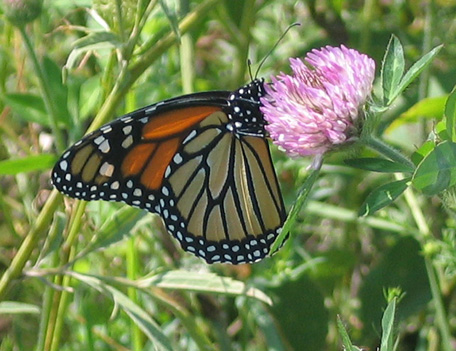
A monarch nectars on clover at Neal Smith National Wildlife Refuge
During the summer of 2004, field research on monarch "resident populations"
was conducted
at Neal Smith National Wildlife Refuge near Prairie City, Iowa, to determine
the butterfly population in advance of the fall migration over the refuge.
The photograph above was taken in mid-August a few weeks prior to the migratory
traffic through the area.
Sunday, August 29--Five monarch butterflies were observed flying over
our butterfly garden in Altoona,
Iowa, on Saturday and Sunday. All five were floating in the sky in one way
monarchs move
during their fall migration. I think it's likely the monarchs were early indicators
the migration to Mexico has begun.
Monday, August 30--Fifteen monarchs were observed in our butterfly garden,
the last eight
of which came through the garden in a brief time during the late afternoon.
Our home is in the older part
of Altoona, approximately two blocks from an opening to the prairie on the
north. The butterflies were
flying in from the north and clearly were migrating.
Tuesday, August 31--During a half-hour visit to Neal Smith National Wildlife
Refuge near Prairie City,
six monarchs were observed.
Wednesday, September 1--Seven monarchs were observed in 45 minutes at
the Neal Smith National
Wildlife Refuge. One was nectaring on tickseed sunflowers in a roadside ditch.
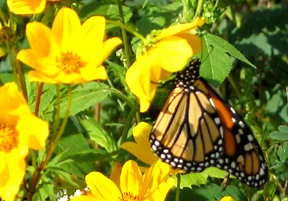
Friday, September 3--Nine monarchs were observed in the middle of the
day--including one in our butterfly
garden and five at Neal Smith National Wildlife Refuge. A road trip through
southeast Iowa in the
afternoon turned up only two monarchs.
Monday, September 6--Four monarchs were flying about our butterfly garden
in the late afternoon.
The limited number of monarch sightings seemed to parallel the reports from
other parts of the Midwest.
Tuesday, September 7--More than 90 migrating monarchs were observed during
a 2 1/2-hour morning
visit to Neal Smith National Wildlife Refuge. The monarchs were nectaring
on thistles, goldenrod,
native purple aster, clover, and tickseed sunflowers (also known as bur marigolds
and other regional names). The temperature was in the 50s , and a breeze was
blowing from
the northwest, so the most monarchs were found in more protected areas on
the refuge.
The total number was the largest observed so far this fall.
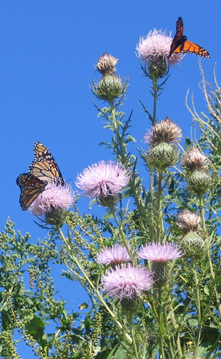
Three Monarchs on September 7
Wednesday, September 8--Today was a "magical moment"
in observations of the monarch
migration at Neal Smith National Wildlife Refuge near Prairie City, Iowa.
Nearly 290
monarchs were counted in three hours, but in one 45-minute span, 180 monarchs
provided the magical moment while nectaring on a stand of clover
in a valley and on a hillside. They were flying to and fro, swirling around
my head,
and landing on the blossoms to feed. It was one of those beautiful times when
all seems right in our natural world.
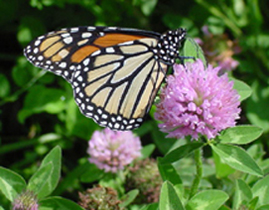
Migrating Monarch Nectars on Clover
Thursday, September 9--Two-hundred and thirty-five migrating
monarchs were counted
during a three-hour visit to Neal Smith National Wildlife Refuge this morning.
Once again, many of the monarchs were observed nectaring on a large stand
of clover
in the refuge. Another stand of clover a half-mile away is not as fully developed,
and only a single monarch was noted there. Single monarchs also were seen
on thistles, tickseed sunflowers, and goldenrod. Few monarchs have been seen
along the highways in central Iowa these days.
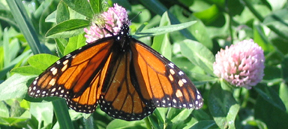
Clover Serves As Popular Choice These Days
Friday, September 10--Two visits were made to Neal Smith
National Wildlife Refuge--one
in the morning and another in the late afternoon. The clear, sunny days continued
in central
Iowa, but the wind today was from the south at 10 to 20 mph. During 2 1/2
hours in the morning,
240 monarchs were observed. Most were nectaring in two stands of clover on
the refuge--
especially on a hillside where the monarchs were out of a direct wind. Thistles
also are attracting
the monarchs. During a one-hour return visit from 4 p.m. to 5 p.m., the count
of monarchs
was 386. One particular stand of clover was the major attraction, and the
possibility existed that many of the monarchs were spending the full day or
more
in the area before continuing their southerly migration. The number of monarchs
in the afternoon clearly was heavier as a constant activity was observed.
Sometimes as
many as 15 monarchs could be seen flying high and low over the stand of clover.
Saturday, September 11--Clover continued to be the primary
nectaring source for migrating
monarchs at Neal Smith National Wildlife Refuge on this day. During 2 1/2
hours in the
morning, 440 monarchs were observed in the refuge. Many of them were nectaring
on
stands of clover. The total counted was the highest yet in one observation
period this fall.
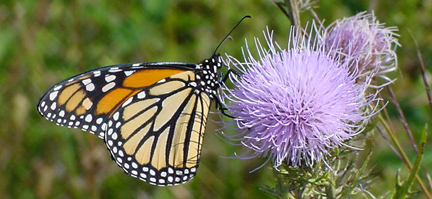
Migrating Monarchs Also Are Stopping on the Thistles
Sunday, September 12--Migrating monarchs continued to nectar
on clover as a primary
source on Sunday. Several also were observed stopping atop the thistles. In
a three-hour
observation at Neal Smith National Wildlife Refuge, 270 monarchs were counted.
More monarchs were observed in the northern area of the refuge, likely indicating
the arrival of new visitors on the way south.
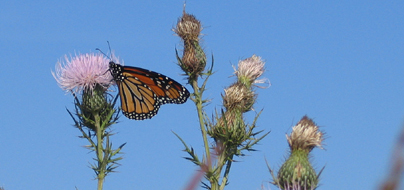
A Beautiful Sunday Morning, Blue Sky, and Migrating Monarch
Monday, September 13--Ninety monarchs were spotted during
a one and one-half hour
visit to Neal Smith National Wildlife Refuge. Strong winds from the south
southeast
appeared to limit the movement of the monarchs.
Tuesday, September 14--A rainy morning and dampness slowed
the movement of
monarch butterflies at Neal Smith National Wildlife Refuge. A walk through
two large
stands of clover turned up 68 monarchs nectaring on the plants as the rain
ended, but
little monarch activity was noted elsewhere during a one and one-half hour
visit.
Wednesday, September 15--Several counties in northern Iowa
received 6 to 12 inches
of rain overnight Tuesday into Wednesday. I was left wondering how migrating
monarchs could deal with such a situation. About one-half inch of rain fell
in places
in central Iowa, and an afternoon visit to Neal Smith National Wildlife Refuge
turned up 45 monarchs once the sun came out.
Thursday, September 16--The sun was shining, the day was
cool, and the monarchs
were nectaring again at Neal Smith National Wildlife Refuge. In 2 1/4 hours
of
observations during the morning, 190 monarchs were counted. Most were nectaring
on clover; a few were seen on thistles.
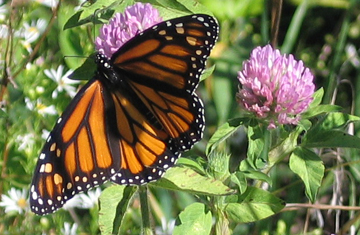
Monarch Migrating on a Sunny Day in Iowa
Friday, September 17--Nine monarchs were observed during
the morning in our
butterfly garden in Altoona, Iowa. And for the first time this autumn, one
of the
monarchs sought out the native purple asters for nectaring--replaying a sight
that
has occcurred hundreds of times in past migratory seasons. Cooler weather
and
rain storms to the north appeared to bring more monarchs south during the
day.
During one and one-half hours of observation at Neal Smith National Wildlife
Refuge,
345 monarchs were counted in the late afternoon. The stands of clover continued
to be
the popular choice for nectaring. All in all, it was a great day for observations.
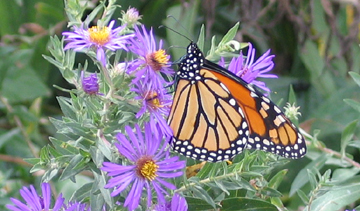
Monarch Finds Purple Aster in the Butterflly Garden
Saturday, September 18--In two hours of observations at
Neal Smith National Wildlife
Refuge, 330 monarchs were observed. Most were nectaring on clover. It's interesting
to
note that popular nectaring choices of past years--including sawtooth sunflowers,
goldenrod, and purple asters--are drawing few monarchs this year.
Sunday, September 19--The numbers of migrating monarchs
continue to be fairly
steady at Neal Smith National Wildlife Refuge. On Sunday morning, the largest
daily total this fall was observed--465 monarchs in two hours. Three-hundred
of
them were counted in a 50-minute span nectaring on one field of clover. This
may
represent the peak time in the migration in central Iowa. The cooler weather
and
rains to the north for several days seem to have spurred the monarchs to move
south.
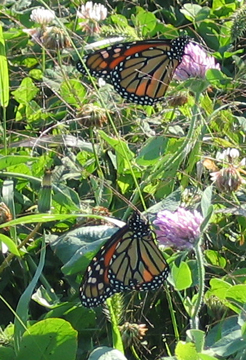
Sunny Sunday Morning at Neal Smith National Wildlife Refuge
Monday, September 20--Migrating monarchs continued to fill
the air in several areas
of Neal Smith National Wildlife Refuge. In two stands of clover, the monarchs
could be
seen flying about in twos, threes, and fours as they chased across the fields.
In an hour and
15 minutes, 240 monarchs were counted as they sought the nectar from the clover.
Tuesday, September 21--Strong winds were blowing from the
south southeast on a clear
and beautiful day. Monarchs still were nectaring on stands of clover at Neal
Smith
National Wildlife Refuge, and in one-hour of observation at midday, 413 monarchs
were counted. Many were seen rising up quickly from the clover to ride the
winds of the day
to other points across the prairie.
Wednesday, September 22--Monarchs were more active across
central Iowa, and single ones
could be observed throughout the warm day moving south. In the midday hours,
17
monarchs were observed in our butterfly garden in Altoona. In late afternoon,
the largest
daily observational count of the season turned up 525 monarchs in an hour
and one-half
at Neal Smith National Wildlife Refuge near Prairie City. Once again, two
fields of
clover were providing the key source of nectar for the migrating monarchs.
Thursday, September 23--A cold front and a light rain came
through central Iowa
during midday, spurring some movement of migrating monarchs. Nine monarchs
were
observed flying through our butterfly garden as the front passed and when
the sun
came out later in the afternoon. In other years, the passage of cold fronts
has brought a major movement of monarchs over the area.
Friday, September 24--The weather cooled down this morning
in the wake of Thursday's
cold front, and monarchs could be seen moving to the south. In the northern
part of
Neal Smith National Wildlife Refuge, 20 monarchs were counted in 20 minutes
with single
monarchs passing south at the rate of about one a minute. Further into the
refuge, a
pleasant surprise occurred when seven monarchs were seen nectaring on some
purple asters along the roadside. This was the first time this fall monarchs
were observed on purple asters at the refuge. During a visit of one hour and
45
minutes, 115 monarchs were counted. Seventy monarchs were noted on stands
of clover
that had been heavily populated with monarchs earlier in the week.
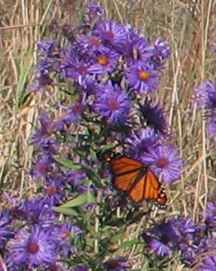
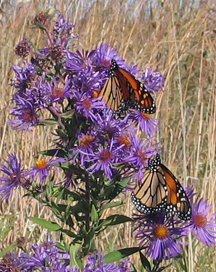
Migrating Monarchs and Purple Asters Tell the Story of Autumn
Saturday, September 25--Two-hundred and fourteen monarchs
were counted during
a visit of one and one-half hours to Neal Smith National Wildlife Refuge.
The monarchs
were nectaring primarily on clover as they prepared for their movement on
south.
Sunday, September 26--A lot of monarch movement was observed
during a two-hour
morning visit to Neal Smith National Wildlife Refuge. Some of the monarchs
were moving
south across the prairie. Many others were nectaring on stands of clover.
And in a flurry
of activity just prior to noon, seven monarchs stopped off for some nectar
on thistles.
In the two hours, 340 monarchs were counted.
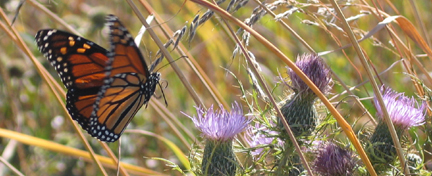
Monarch Heads for a Thistle for Some Nectar
Monday, September 27--Three monarchs were observed passing
through our butterfly
garden during the day. Migration activity continued at Neal Smith National
Wildlife
Refuge. One-hundred and thirty-six monarchs were noted during one hour of
counting.
Tuesday, September 28--A brisk wind from the north and
cooler weather led to the apparent
departure of migrating monarchs from the area. Only four monarchs were observed
during
a 45-minute visit to Neal Smith National Wildlife Refuge. Those were counted
on clover
fields that had been quite active with monarchs in the last week.
Wednesday, September 29--A frost advisory to the north
for Tuesday overnight suggested
the days for monarch movement this fall are declining if not ending. Two monarchs
were
seen around our butterfly garden Wednesday, and 10 monarchs were counted during
a 45-minute visit to Neal Smith National Wildlife Refuge.
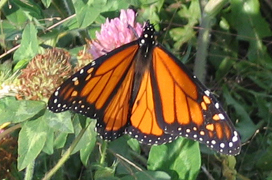
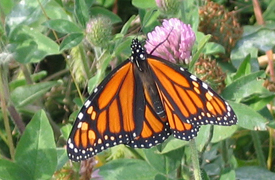
On September 27, It's Clover Time Once Again for Migrating Monarchs
Thursday, September 30--On the final day of September,
the prairie at Neal Smith National
Wildlife Refuge showed the beautiful tones of autumn, and a few remaining
monarchs
were nectaring on a field of clover on a hillside. In one hour and one-half,
the count was
19 monarchs. But the weather predicted for the days ahead suggested the end
of the
monarch migration season is upon us in central Iowa. The overnight low temperature
for
Friday night is expected to be 31 degrees.
Sunday, October 3--The day was sunny, the wind was brisk,
and the cool of autumn could
be felt in the air. No monarchs were sighted at Neal Smith National Wildlife
Refuge during a visit,
and the end of the migration season appeared to be at hand. Two lonely monarchs
were
noted flying south across the highway on the drive to and from the refuge.
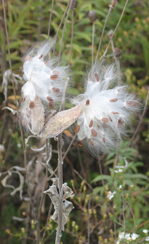
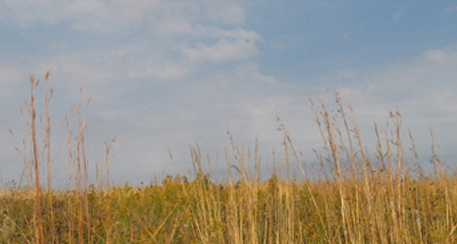
The Beauty of Autumn Shows Through on the Prairie in Central Iowa